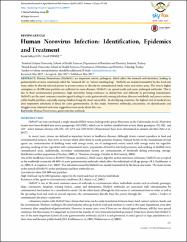Human Norovirus Infection: Identification, Epidemics and Treatment
Abstract
Human Noroviruses (HuNoVs) are important enteric pathogens, which affect the stomach and intestines, leading to gastroenteritis or more commonly called the "stomach flu" or “winter vomiting bug". HuNoVs are mainly transmitted by the fecal-oral route, either by directly infected person-to-person contact or directly via contaminated foods, water and surface areas. The virus is highly contagious as 10-100 virus particles are sufficient to cause diseases. HuNoVs can spread easily and cause prolonged outbreaks. This is due to their environmental persistence, high infectivity, being resistance to disinfection and difficulty in preventing transmission. HuNoVs are the most common causative agent leading to acute gastroenteritis among infectious diseases worldwide and poses a serious public health problem, especially among children being the most susceptible. In developing countries, the highest cost of medical care after respiratory infections is listed for acute gastroenteritis. In this study, Norovirus outbreaks, precautions, its identification and struggles were informed and some suggestions were made about this case.
Volume
3Issue
1Collections
The following license files are associated with this item:


















